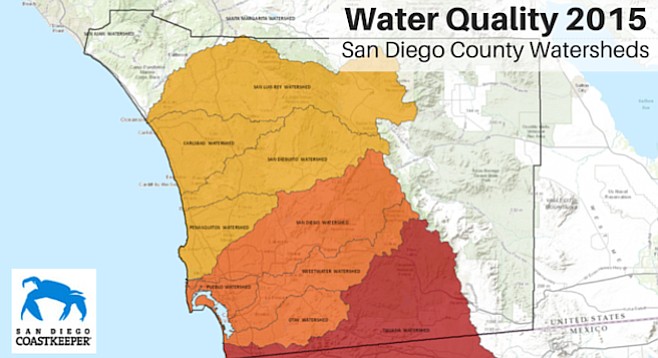 Facebook
Facebook
 X
X
 Instagram
Instagram
 TikTok
TikTok
 Youtube
Youtube

Water-quality watchdog San Diego Coastkeeper released results on Tuesday (May 10) of its annual water-quality survey that compiles monthly data collected from San Diego's nine watersheds. As has been a trend in recent years, the results were not pretty.
"In 2015, all nine of the watersheds tested as Fair, Marginal or Poor on San Diego Coastkeeper’s Water Quality Index scoring system, all earning the same abnormally low scores as 2014," states an introduction to the report. "Very low water levels as a result of our fourth consecutive year of drought are partially to blame for the continued poor water quality scores. In 2015, we had more sites with water levels so low they were too dry to collect samples than any other year in our recent history."
Particularly concerning, the group says, are high levels of fecal bacteria and low levels of dissolved oxygen measured in the creeks and streams that are still flowing. Low oxygen conditions lead to the death of native plants, fish, and other water wildlife, which can lead to excess bacteria. That bacteria problem is already more prevalent due to fecal contamination, and results in toxic runoff that can make the region's beaches unsafe, particularly following rarer-than-normal rainstorms that wash built-up waste out to sea.
"Rain, wind and storm drains bring trash and toxic runoff to our inland waters where it travels straight to the ocean," says Coastkeeper lab coordinator Meredith Meyers. "Even pollution that begins miles away from the coast can reach the Pacific, where it harms fishing populations and our coastal wildlife."
Water quality, which nearly 200 volunteers spent about 1800 hours monitoring over the past year, ranged from poor (14 on a 100-point scale) in the Tijuana River region to fair (80 points) in the San Luis Rey and Carlsbad watersheds. Generally, as distance increased from the U.S./Mexico border — where Mexican sewage-treatment plants routinely overflow during heavy rains — water quality improved.


Water-quality watchdog San Diego Coastkeeper released results on Tuesday (May 10) of its annual water-quality survey that compiles monthly data collected from San Diego's nine watersheds. As has been a trend in recent years, the results were not pretty.
"In 2015, all nine of the watersheds tested as Fair, Marginal or Poor on San Diego Coastkeeper’s Water Quality Index scoring system, all earning the same abnormally low scores as 2014," states an introduction to the report. "Very low water levels as a result of our fourth consecutive year of drought are partially to blame for the continued poor water quality scores. In 2015, we had more sites with water levels so low they were too dry to collect samples than any other year in our recent history."
Particularly concerning, the group says, are high levels of fecal bacteria and low levels of dissolved oxygen measured in the creeks and streams that are still flowing. Low oxygen conditions lead to the death of native plants, fish, and other water wildlife, which can lead to excess bacteria. That bacteria problem is already more prevalent due to fecal contamination, and results in toxic runoff that can make the region's beaches unsafe, particularly following rarer-than-normal rainstorms that wash built-up waste out to sea.
"Rain, wind and storm drains bring trash and toxic runoff to our inland waters where it travels straight to the ocean," says Coastkeeper lab coordinator Meredith Meyers. "Even pollution that begins miles away from the coast can reach the Pacific, where it harms fishing populations and our coastal wildlife."
Water quality, which nearly 200 volunteers spent about 1800 hours monitoring over the past year, ranged from poor (14 on a 100-point scale) in the Tijuana River region to fair (80 points) in the San Luis Rey and Carlsbad watersheds. Generally, as distance increased from the U.S./Mexico border — where Mexican sewage-treatment plants routinely overflow during heavy rains — water quality improved.
Comments